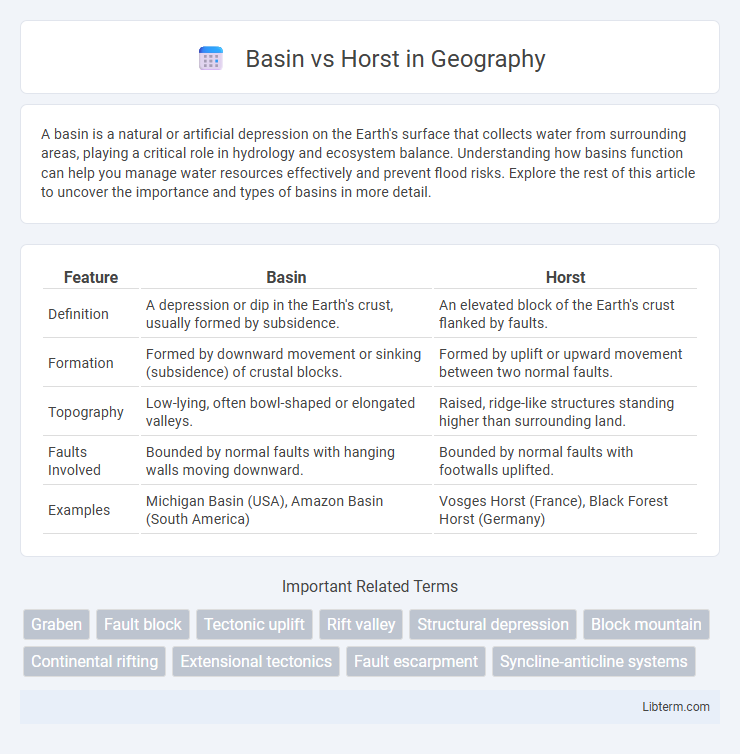A basin is a natural or artificial depression on the Earth's surface that collects water from surrounding areas, playing a critical role in hydrology and ecosystem balance. Understanding how basins function can help you manage water resources effectively and prevent flood risks. Explore the rest of this article to uncover the importance and types of basins in more detail.
Table of Comparison
| Feature | Basin | Horst |
|---|---|---|
| Definition | A depression or dip in the Earth's crust, usually formed by subsidence. | An elevated block of the Earth's crust flanked by faults. |
| Formation | Formed by downward movement or sinking (subsidence) of crustal blocks. | Formed by uplift or upward movement between two normal faults. |
| Topography | Low-lying, often bowl-shaped or elongated valleys. | Raised, ridge-like structures standing higher than surrounding land. |
| Faults Involved | Bounded by normal faults with hanging walls moving downward. | Bounded by normal faults with footwalls uplifted. |
| Examples | Michigan Basin (USA), Amazon Basin (South America) | Vosges Horst (France), Black Forest Horst (Germany) |
Introduction to Basins and Horsts
Basins are large-scale structural depressions characterized by downward warping of sedimentary layers, often accumulating thick sequences of sediments due to prolonged subsidence. Horsts are elevated blocks of the Earth's crust bounded by normal faults, formed by extensional tectonic forces that cause adjacent land to drop, resulting in fault-block mountains or plateaus. Understanding the contrasting formation and geometry of basins and horsts is essential for geological mapping, resource exploration, and seismic risk assessment.
Geological Definitions of Basin and Horst
A basin is a geological depression or low-lying area formed by subsidence or tectonic downwarping, often filled with sedimentary deposits over time. A horst is an uplifted block of the Earth's crust, bounded by faults, standing higher than the surrounding terrain, typically formed due to extensional tectonic forces. Basins and horsts together characterize fault-block terrains where contrasting vertical movements create distinct topographic highs and lows.
Formation Processes of Basins
Basins form primarily through subsidence caused by tectonic activity, sediment loading, or crustal thinning, creating depressions that accumulate sediments over time. Normal faulting and extensional forces stretch the crust, causing it to sink and form these sedimentary basins. Unlike horsts, which are elevated blocks bounded by faults, basins represent down-dropped blocks that serve as significant reservoirs for hydrocarbons and groundwater.
Formation Processes of Horsts
Horsts form through extensional tectonic forces that cause the Earth's crust to fracture and uplift blocks between two normal faults. These uplifted blocks remain elevated as adjacent grabens or basins subside due to crustal thinning. The formation process involves brittle deformation and vertical displacement, often observed in rift zones or regions experiencing crustal extension.
Key Differences Between Basins and Horsts
Basins and horsts are geological structures formed by tectonic forces causing the Earth's crust to warp and fracture. A basin is a downward-sloping depression where sediment accumulation occurs, often creating fertile land or water reservoirs, while a horst is an uplifted block bounded by faults, typically forming elevated ridges or mountains. Key differences include their relative elevation (basins are low-lying, horsts are elevated), fault boundary types (normal faults surrounding both but causing opposite vertical movements), and their roles in sediment deposition and erosion processes.
Examples of Famous Basins and Horsts
The Michigan Basin in North America and the Paris Basin in Europe are renowned examples of sedimentary basins known for their rich oil and gas reserves. The Harz Horst in Germany and the Vosges Horst in France exemplify horsts characterized by elevated fault-block mountains formed through crustal extension. These geological structures play critical roles in regional topography and resource distribution, influencing sediment deposition in basins and tectonic uplift in horsts.
Tectonic Settings of Basins and Horsts
Basins form in extensional tectonic settings where crustal thinning leads to subsidence, creating low-lying areas that accumulate sediments. Horsts develop in similar extensional regimes but represent uplifted blocks bounded by normal faults, standing higher than the surrounding terrain. These structures often coexist in rift zones, reflecting differential vertical movements during crustal extension.
Economic Importance of Basins and Horsts
Basins often contain rich deposits of hydrocarbons, coal, and minerals, making them vital centers for energy extraction and mining industries that significantly boost regional economies. Horsts, characterized by elevated blocks, frequently serve as stable platforms for infrastructure development and can expose valuable mineral veins, contributing to mining viability and tourism. The economic importance of basins and horsts lies in their contrasting roles as reservoirs of natural resources and stable landforms promoting industrial and commercial activities.
Environmental Impacts on Basins and Horsts
Basins often accumulate sediments and organic matter, creating rich habitats that support diverse ecosystems but can also trap pollutants, leading to water quality degradation and habitat loss. Horsts, characterized by elevated terrain and steep slopes, are prone to soil erosion and reduced vegetation cover, impacting runoff patterns and increasing sedimentation in adjacent basins. Both geological structures significantly influence local hydrology and biodiversity, necessitating tailored environmental management strategies to mitigate erosion, sedimentation, and pollution risks.
Summary: Basin vs Horst Comparison
A basin is a geological depression where rock layers dip inward, creating a downward-curving structure typically filled with sediments, while a horst is an elevated block of the Earth's crust bounded by faults, forming a raised block relative to surrounding areas. Basins often serve as sediment accumulation zones crucial for hydrocarbon reservoirs, whereas horsts act as uplifted blocks that can expose older rock formations. The key difference lies in their structural formation and topographic expression, with basins representing synclinal downward warps and horsts representing fault-bounded uplifted blocks.
Basin Infographic

 libterm.com
libterm.com